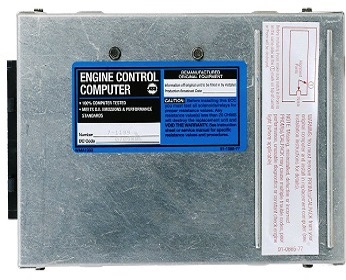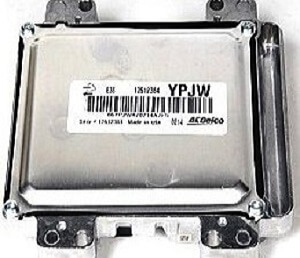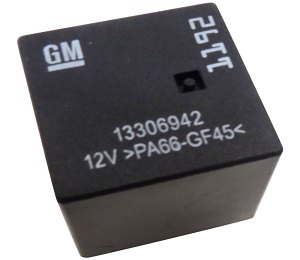Sensor and Car Computer Problems
This car computer problems page will connect you to in-depth and detailed articles about common automotive sensor problems.
You can scroll to the bottom and rummage through the list of topics. Better yet, you can read your way down there and learn about the heart of the engine management system.
The computer, also called an engine control module, receives inputs from the individual sensors. The plastic throttle position sensor provides an excellent example of an input sensor.
All data is analyzed in the same module. Using this received information the ECM Outputs commands to the various control devices like the fuel injector and the ignition control module.
Here we’re going to talk about the difference between computers mounted in automobiles from the 80s and 90s and the vastly different units found in vehicles from the late 90s and 2000 decade.
More importantly, we'll talk about properly diagnosing car computer problems and how to replace them when needed.
 GM Engine Control Module
GM Engine Control ModuleHow Often do Car Computers Go Bad
This is a complicated question that has a lot to do with the year, make and model car it's installed in. Nevertheless, I’ll say the general answer of not often, but provide a further explanation.
In the mid-80s when these computers started showing up in every car built so it could comply with stricter emission standards and fuel economy ratings, mechanics wanted to replace them often.
The lack of proper training led to many misdiagnosed and wrongfully replaced modules. Often the root cause of the driver complaint turned out to be a tuneup or maintenance problem. As a young dealership line technician from this time period my employer sent me to intensive factory training.
 Next Generation GM ECM
Next Generation GM ECMI quickly learned to use automotive diagnostic code readers and figured out how to tell the difference between a bad computer and one that was malfunctioning for various reasons.
I will share details with you, but I wanted to make you understand how General Motors felt about how often the car computer fails. After studying the returned units, less than 10 percent actually had a malfunction.
This meant that 90 percent of the replaced ECM's had nothing wrong with them. Another conclusion from the study found that dealership technicians replaced multiple sensors and computers for a single driver complaint.
At that point General Motors adopted a policy of replacing only one part per driver complaint. Dealerships submitting multiple parts on a single line ticket would have that claim bounced. In other words, you could no longer throw a Chevrolet 02 sensor part on a claim with a failed powertrain control module.
Do Car Computers Ever Go Bad
The short answer is yes, they do fail at times. In fact General Motors had a blunder with one of their most popular electronic control modules. After 30 years of water under the bridge, I still remember the ECM part No. 1227730.
This particular unit became plagued with problems. The main circuit board that carried the programmable read only memory chip was supper thin and brittle.
These computers went into millions of cars from the model year 1987 through 1993. Some really popular cars like the Cavalier, Firebird and Camaro all had the same computer.
These vehicles also had a new design mass airflow sensor. The sensors worked so poorly that General Motors had to come out with a special repair policy for customer satisfaction purposes.
The fix was to replace the PROM (Programmable Read Only Memory) unit on the ECM board with a reprogrammed set of instructions. General Motors called this the speed density update.
Basically it used the manifold absolute pressure sensor for engine load data instead of the mass airflow sensor. When mechanics replaced the PROM they had to seat it on the weak motherboard. The operation would cause hairline cracks and intermittent operation of the ECM.
These cars would come back multiple times for intermittent car computer problems that were difficult to search down. Eventually the General figured out that any unit with a 1227730 ECM that had the speed density update performed, would probably need a replacement computer.
How to Diagnose Car Computer Problems
In many cases it's not the controller or the module, but the sensors they read and the actuators they control that remain the root cause. As an example, the Honda VTec solenoid and spool valve fail more often then the module that energizes them.
In the example of the 1227730 ECM, mechanics came up with an easy trick to diagnose a bad unit. If the circuit board had hairline cracks you could tap the outer case of the computer with the handle of a screwdriver.
If it needed replacing the check engine light came on and the engine ran poorly. On newer automobiles it's much more difficult. When I say newer, I'm talking about old cars from the 1990s and early 2000 model years.
When these vehicles have a bad ECM it's usually the output of a reference voltage problem. When this happens a car might possibly set a crankshaft position sensor code, because a 5 V reference wasn't sent out from that ECM. This kind of pinpoint diagnosis takes some skill and a good auto repair manual.
 ECM Power Relay
ECM Power RelayIn some isolated cases we've seen defective coolant temperature sensors allow antifreeze to travel the length of the reference signal wire and wet the connector of the ECM.
This small amount of moisture can easily destroy an engine control module. Long story short, when you unplug a control module it should look like brand new inside. Finally, every computer needs power and a good ground.
Many models use a computer power relay. These can fail and the ECM sets power interruption codes like a P2509, power input signal fault. Of course, the ground connection becomes just as important as the power. Corrosion can cause ground integrity problems. Find the system grounds and make sure they are clean and tight.
How to Replace Computers on Old Cars
On vehicles from the 1980s and early 90s, they stored the model specific fuel management operation instructions on a self-contained replaceable part called the PROM.
This meant when a computer failed you physically switched the PROM chip over to the new unit. The simple procedure didn’t require the need for any special equipment. When vehicles went to OBDII in 1996 they changed to a prom soldered to the circuit board.
Now a replacement ECM requires the use of a flash memory device to program the new computer. Replacing a car computer at home isn't really possible like in the old days. However, this doesn’t mean you have to buy an expensive replacement unit at the dealership.
Aftermarket companies offer refurbished and new replacement car computers. The prices vary with year, make and model, but are usually discounted from retail in the 50 percent range.
Unfortunately, you’ll to have to take the car to a dealership and see if they’re willing to install this aftermarket unit and then flash the prom with your vehicle's instructions.
If everything works out, using this procedure might save several hundred dollars. The dealership will at least charge one hour labor at their going rate to flash the new computer.
Fix Car Computer Problems and Sensor Issues
Welcome to this popular area of the FixMyOldRide.com website. Bookmark the page and check for new content related to common automotive sensor issues and computer problems.
Older Ford cars and trucks are starting to see increased failure rates of the fuel rail pressure sensor. Symptoms include a check engine light code P0190 - P0194, lack of power and hard starting.
I don't often write about the Ford Mustang because it's so well covered on the internet. However, Ive replaced to many Mustang VVT cam actuator solenoids to not talk about why they fail and how to handle replacement.
Problems with a vehicle speed sensor can scare you, because the symptoms often feel like the transmission is going bad. Review a few other symptoms of bad transmission speed sensors.
Speaking of scary, If you have a GM truck from 2003 through 2012 you might get a warning message to turn off the engine. This happens with a malfunction of the oil pressure sending unit. If the computer see's no oil pressure it gets scared.
I don't get to work on on many Mercedes Benz cars. But I did work on a Chrysler Crossfire with the Mercedes 3.2 L engine. See how I fixed a no start condition for under $50 by replacing the crankshaft position sensor.
Car makers use plastic to reduce vehicle weight. Here's one situation where it literally backfired. See the symptoms of a failing Vortec engine plastic distributor.
Some cars and trucks are more likely to have problems with MAF sensors. See the cars and trucks with a high rate of mass air flow sensor failure.
Not all car problems are hard to solve. Example, the P0106 trouble code on the 3800 series engine. See how to repair and diagnose the MAP sensor problem.
Three different sizes of GM 4 cylinder engines set check engine light codes P0110 through P0115 because of a failed part. See how to diagnose and repair a camshaft position actuator solenoid valve problem. The Chevrolet 6 cylinder Trailblazer has the same issue, but with a twist. It might need also need a camshaft position sensor.
The Chevrolet Vortec V6 engine has a strong cast iron block and is capable of lasting for hundreds of thousands of miles. However, you won't get there with the original injector assembly. Review the problems with the Vortec V6 electronic fuel injector.
If you have an old Ford car or truck then you might set a check engine light code in the P0400 - P0409 range. See how to handle diagnosis and repair of EGR codes on Ford pickups.
If you have a GMC or Chevrolet truck you might see a variety of warning messages come up on the driver information center. See how to fix the reduced engine power warning for little or no cost.
Small vapor leak codes remain near the top of common failures that turn on the check engine light. Even Toyota has a common fuel vapor purge solenoid problem. Review a list of other cheap plastic parts responsible for vapor canister purge issues.
Speaking of emission system vapor codes, If you have a GM car or truck from the 2000 decade you might have a fuel tank pressure sensor issue at some point. See how to test and replace the part.
A no start condition on an old Ford is a common problem. This article walks you through diagnosis of the ignition side of the circuit and shows you how to test the Ford ignition module.
The cars computer needs to know the incoming air temperature to calculate the fuel mixture. Here's what happens when the intake air temperature sensor goes bad.
Even reliable Japanese cars have check engine light issues. See the massive amount of cars setting Nissan knock sensor codes.
Another interesting article related to General Motors products. Three separate generations of GM ignition control modules suffer from a high failure rate.
Author bio : Mark is a retired ASE certified master technician, Chevrolet Professional Service Council member and the founder of FixMyOldRide.com. Watch the video on the about Mark the mechanic page to see his credentials. Mark hand writes all of the articles on FixMyOldRide.com unless indicated otherwise.